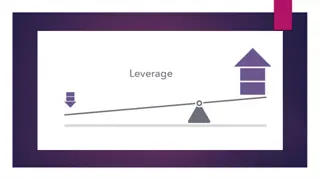Understanding Leverage in Business Finance
Leverage in business finance refers to the use of assets or borrowed funds to increase returns and manage risk. It involves a mix of debt and equity to fund operations and expansion. Equity financing, such as IPOs, involves selling ownership stakes, while debt financing requires repaying borrowed funds with interest. Operating leverage, financial leverage, and combined leverage are key concepts in analyzing the impact of borrowing on a firm's financial structure.
Download Presentation

Please find below an Image/Link to download the presentation.
The content on the website is provided AS IS for your information and personal use only. It may not be sold, licensed, or shared on other websites without obtaining consent from the author. Download presentation by click this link. If you encounter any issues during the download, it is possible that the publisher has removed the file from their server.
E N D
Presentation Transcript
Leverage means the employment of assets or funds for which the firm pays a fixed cost or fixed return. The concept that is used to study the effects of various mix of debt and equity on the shareholder's return and risk in the capital structure of a firm is called leverage.
Leverage refers to borrowing funds for a particular purpose with an obligation to repay these funds, with interest, at an agreed- to schedule. The idea behind leverage is to help borrowers achieve a higher return with a smaller investment.
If and when your business is ready to increase its scale of operations, expand into new markets, or update existing infrastructure, you re going to need funds. However, if you don t have enough equity or cash upfront, you ll have to borrow funds. Two ways to borrow capital are to issue bonds (equity financing) or borrow directly from lenders (debt financing).Equity financing involves selling your equity in exchange for funding. One of the biggest benefits of equity financing is that it doesn t lead to the company having to make interest payments or any principal repayment. Some of the most common examples of equity financing are initial public offerings (IPOs) and crowdfunding. Debt financing involves a company borrowing money to fund working capital requirements. When a company borrows money, it needs to make interest payments as well as repay the principal. Taking a loan is a common debt financing example.
Operating Leverage Financial Leverage Combined Leverage























